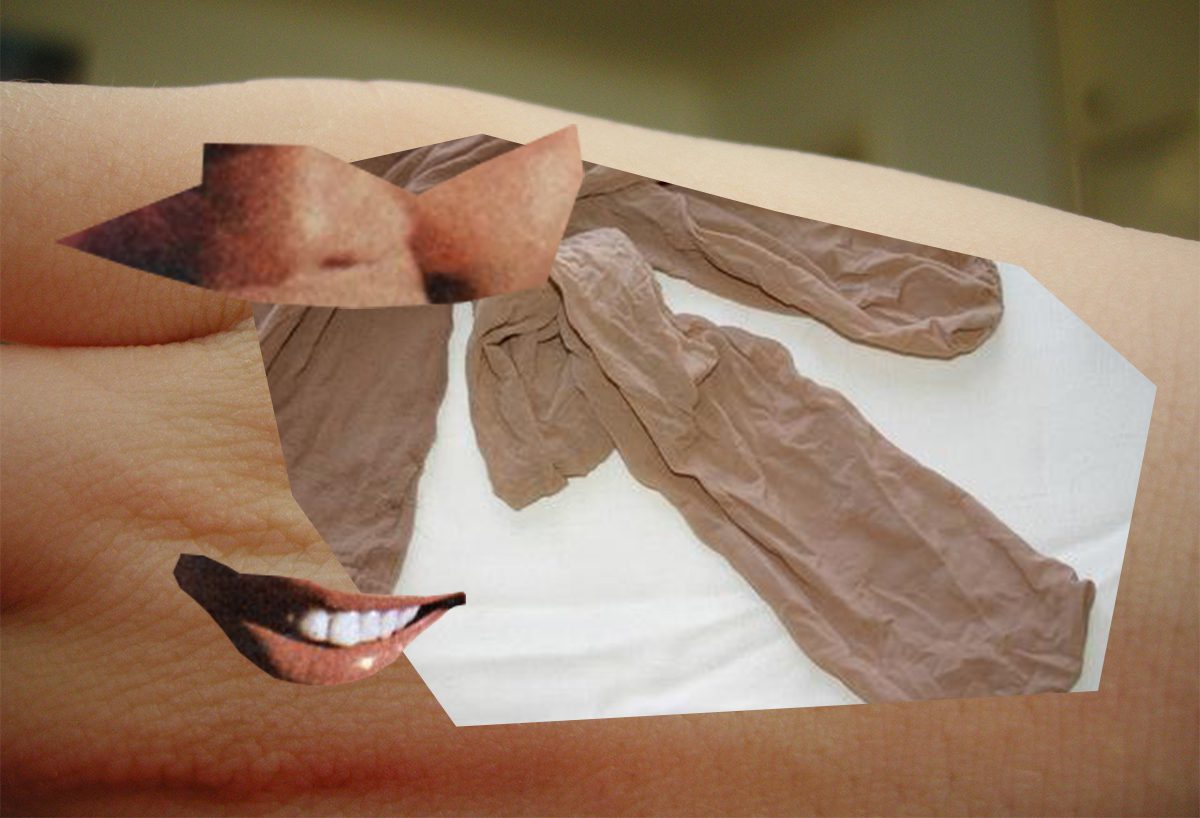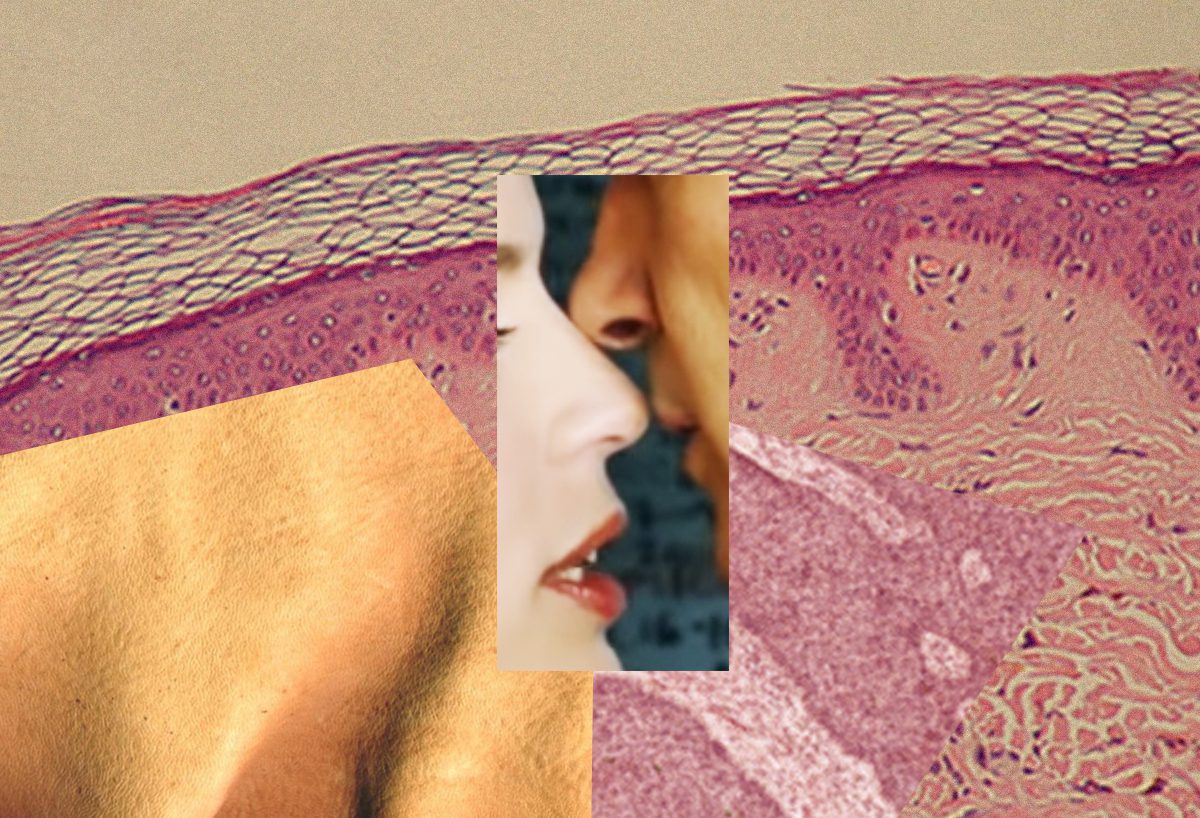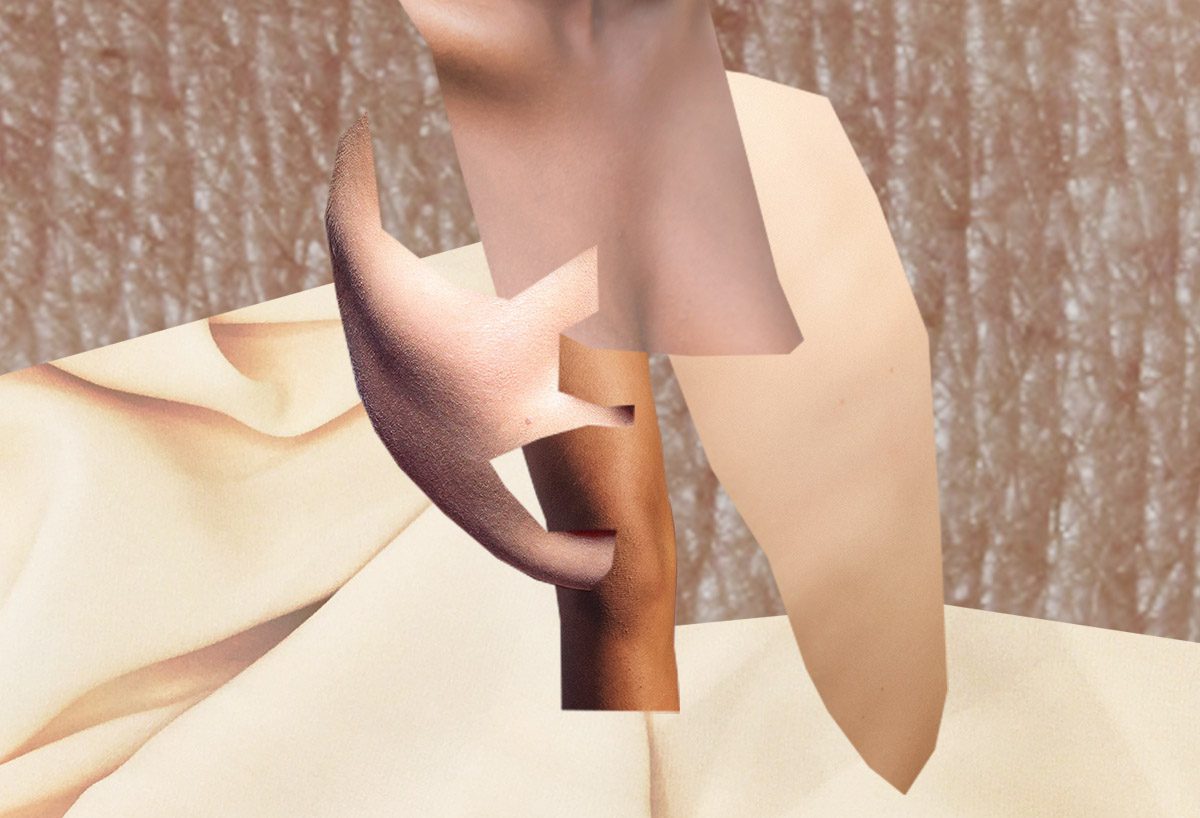As a college student home for the holidays in Los Angeles circa 2008, I made the pilgrimage to the Museum of Contemporary Art. It was worth extracting myself from the haven of my bed to see the Louise Bourgeois survey—the first in the United States. I took strange comfort in moving, almost unseen, through darkly lit rooms full of worn cages covered over by the domineering yet maternal bodies of Bourgeois’s steel spiders. Millennial pink figurative sculptures hung from the ceiling, mottled white and rose like a fatty ham at meat market, the boney wires of their infrastructure just visible underneath.
At home, unable to leave the exhibition behind, I clicked through photo after photo of Louise Bourgeois’s maggot-like cloth figures, their screaming faces muzzled by terrycloth veils. I mused at the degree of control that women have in rendering themselves monstrous. Bourgeois’s sculptures are audacious in their ugliness. Through them, Bourgeois lets both her psyche and body seep, oozing through the thick pink felt of works such as Untitled, 2001. The face, mid-scream, at once freed and frozen, is locked into its own affect. Its own capacity to feel and not feel. I realized that when wielded by women, monstrosity and the grotesque can function as a kind of second skin—a way to temporarily relieve trauma by subverting expectations of sexual objectification.
During the opening scenes of Pedro Almodóvar’s 2011 film The Skin I Live In, I thought immediately of Bourgeois’s work. As a teenager I watched Almodóvar’s films enraptured by the devil-may-care heroines who defied the world in my mother tongue. I poured over interviews with the filmmaker in which he discussed the profound impact that women made on his early life. How generous, I’d thought, that he uses his platform as a successful artist to tell the stories and struggles of women. Only after watching The Skin I Live In did I begin to realize that Almodóvar’s historical identification with women, and in turn his fixation on the violence of masculinity/male desire, only serves to further suppress this desire and encourage a dangerous exercise thereof on the bodies of women. Through ventriloquizing the experiences of women, he by definition erases their authentic expression.
In the beginning of The Skin I Live In, an impish woman in a flesh-colored body suit molds Louise Bourgeois-esk sculptures in her room. This second skin looks unnatural, yet she wears it with ease. The film is set in the medieval Spanish town of Toledo, where antiquated torture machines are sold as souvenirs and guillotines are displayed proudly in shop windows. Roberto, a mad scientist of sorts, played by Antonio Banderas, kidnaps Vicente—the young man who raped Roberto’s daughter Norma. After performing vaginoplasty on Vicente, Roberto eventually reconstructs Vicente’s entire body into that of an anatomical woman, thus making Vicente into Vera, the woman we see at the beginning of the film. He uses Vera to experiment and master an impenetrable artificial skin. Only after Vera/Vicente is raped (by Roberto’s half-brother Zeca, no less) does Roberto face his own problematic desire for Vera/Vicente, and consummates this desire.
The Skin I Live In can be read, as can many of Almodóvar’s works, as partially autobiographical. His aesthetic now canonized, perhaps Almodóvar sees his career as the immobile body on the table. He is both doctor and patient, operating on himself, surgically enhancing and reconfiguring this authorial identity with each film. And usually I’m there for every nip and tuck. But in The Skin I Live In, I am struck by a familiar, almost boring rage at the full-throttle confidence with which men represent female bodies. The Skin I Live In may be in part about the author’s own position within the creative elite, but who is the author or who does he think he is? I found myself asking this question with increasing frequency as I watched the film. Who does Almodóvar think he is?
In a conference talk about the second skin he has invented, Roberto speaks proudly of helping a shapeless mass acquire the features of expression. “For burn victims, saving their lives isn’t enough,” he maintains, equating plastic surgery with heroism. As surgeon, Roberto is the architect of someone else’s face, someone else’s identity. Yet throughout the film we gain a growing sense that Roberto—who manipulates and recreates the female body to satisfy a personal vendetta—is in fact this shapeless mass, contoured into character only through his response to his own trauma (primarily, his failed relationships with women). By enlivening the “shapeless mass” to materiality, Roberto gives life while also prescribing a kind of death, binding Vicente to a gender that he has not assigned himself, thus perpetuating Almodóvar’s particular brand of paternal contagion in his male characters—as film scholar Dean Allbritton implies in his essay, “Paternity and Pathogens: Mourning Men and the Crisis of Masculinity in Todo Sobre Mi Madre and Hable Con Ella,” men who birth death.
But a male contagion to what end? The presumed generosity of Almodóvar’s attention to women and women’s issues in his films might only serve to further fracture men and their emotions from one another. Almodóvar’s insistence on a male contagion while purporting to “liberate” women through misguided representations only serves to perpetuate female subordination and male fragility. The question I am asking here is not whether men should represent women’s bodies, but why should they? Can forced sex changes and serial rapes as revenge really serve to further an agenda of gender equity, especially when a man wields this plot? Almodóvar is known for utilizing a theory of trauma that centers around the curative properties of repeating or recreating trauma, yet can this same theory be applied when we talk about sexual violence?
Two years ago, I found myself moved after reading the letter that a former Stanford student wrote to her attacker, Brock Turner. I posted the following on social media:
By now most of you have heard about the Stanford victim’s letter to the man who raped her. I read it this morning just as I was settling in at work, which was a mistake. If you have not read it yet, I do not recommend reading it alone. Read it when there is someone with you to hold your hand. Who can rub your back, make you some tea, and take you to a “warm and soft place” just as the letter describes.
I wish I had read it with other women around me—who felt her pain on a corporal level the same way I did. Who recognized her words as searing, white-hot truth.
I have had difficult conversations with the kindest of men on how to help the women in their lives feel safe. I understand that this doesn’t come easily to many men, because, for a lot of us women, it doesn’t come naturally to us either. From an early age, most women are trained to endure physical, sexual, and emotional harassment. We are told that this endurance is part of our purpose in life; it is wrongly packaged as “strength.” This takes its toll in a lifetime, throughout generations.
Among the outpouring of support and solidarity I received after posting, only a few men responded. The next morning I woke up to a message from a high school friend I had lost touch with in which he drunkenly listed what he liked about my body and all the things he had wished to do to it back in high school. In this typo-riddled missive, he pleaded for me to let him do those things now. “I know how to do it now and Id really appreciate gett9thr cha9 [getting the chance]. I just wanted to tell you how I felt before i died,” he wrote.
My first reaction was disgust. I could not fathom how a posting in solidarity with victims of sexual abuse could elicit sexual harassment. Besides, we had been friends, this boy and I. I was his forever roady at his shows. He’d painstakingly cultivated my love of classic rock. He had lifted me onto his shoulders so I could see at concerts. He pushed me through crippling panic attacks. We spent many summers smoking weed in the dry heat of his backyard, or winding slowly up the San Gabriel Mountains on Angeles Crest Highway telling ghost stories. In so many ways he had modeled healthy platonic friendship.
And yet this. All of a sudden all the good times we shared were distilled down to unrequited lust. I threw my phone across the room, sickened and angry at this response to my, albeit naive, feminist call to action. But in re-reading them a few hours later I realized that his messages betrayed a sticky vulnerability. That it was less an expression of erotic desire, and more of a plea for that desire to be seen.
In The Skin I Live In, the phallic is fatal. Roberto tries to phallicize himself by de-phallicizing Vicente. For the men in the film, the excess of their desire and their inability to control it is their fragility. Roberto shoots Zeca, a home-invader, moments after Zeca violently rapes Vera. Roberto, too, is plagued by his own wanting, which twists him into a monster capable of kidnapping, murder, and assault. Both the suppression and satisfaction of desire are his undoing, manifesting his eroticism into sick surgical practice. When Roberto finally makes himself vulnerable and gives in to his dysfunctional desire for Vera, Vera kills him.
Throughout Roberto’s grandiose home hang large paintings and sculptures of faceless nudes. They linger in the background of many shots, indicating an anonymous, unwilling intimacy to anyone who will meet their unfocused gaze. At the end of the film we get the sense that Roberto is himself the faceless nude, hanging vulnerability on his walls to satiate his own deep desire to be vulnerable. Yet, the female body again becomes the vessel for male desire—Roberto requires the shade of a woman’s body to unmask himself.
While condemning or sickening masculinity, The Skin I Live In also protects it. Almodóvar uses the female body to intervene in dysfunctional male identity formation. We learn from Freud that skin lays the groundwork for ego development. When early trauma occurs, people can form a psychological defense known as a “second skin.” In The Skin I Live In, Vicente/Vera is forced to wear their skin both as a body suit and as a nonconsensual sex change. In a sense, Roberto takes away Vicente/Vera’s ability to form their own second skin, to choose which way to protect themself from trauma. Louise Bourgeois understood this urge to wear one’s pain, and to define it for one’s self, more than anyone. An avid student of psychoanalysis, she viewed her work as release. “Her artwork was reparative,” the Guardian’s Christopher Turner writes, “a form of mental mending.”
I read that Louise Bourgeois’s mother was a tapestry restorer. How very frustrating, how very painful to see your mother fix something again and again while so much inside of you is broken. So much that, perhaps, she could repair. Bourgeois became her own mender, in fabric, bringing to life the visions of herself as vulnerable, fetal, barely formed—things that had only previously existed in herself, but that exist in all of us. The point about The Skin I Live In is that it does not mend. It does not restore. In my opinion, that should be the work of a male-authored film that deals with women’s bodies. Anything else is just repeating a dangerous history.
In a letter to Mon cher Papa, Louise Bourgeois writes, “In the 20th century the best work has been produced by those people whose exclusive concern was themselves.” I was trained by the men around me to admire people like Picasso, who used the bodies and emotional labor of women for creative production. I grew up in an environment in which a man’s career trumped all, even the basic needs of his family. Looking at Bourgeois’s fabric sculptures, I am reminded of the impossibility of the female body to meet the demands imposed upon it—at once maternal, arousing, tender, resilient. For me, Louise Bourgeois’s work carries this weight—the contradictions of our sex. As a woman, I too have felt the bi-directional demands of feeling and not feeling, especially within the context of sexual violence. I have felt the need not to feel while feeling—to shut down the sensory overload when my body is overpowered, when a force signals that my body is no longer mine.
Ironically, Almodóvar enlists the works of Bourgeois to address the trauma of sexual violence, of entrapment. But in doing so he also renders null the meaning of her work—he instrumentalizes her sculpture, her second skin, for his own creative expression, therefore perpetuating a lineage of male artists who co-opt female labor. The problem with Almodóvar’s brand of solidarity is that it overshadows the efforts that female artists have made to articulate, and therefore overcome, their trauma. Or, as a friend of mine put it, “He’s just another dude.”
Perhaps this is why I reacted so strongly when I saw The Skin I Live In. Almodóvar, the cinematic “father” I had so long admired, slots so easily into the Western fine art world’s “founding fathers” who have used women as ciphers for their own self-loathing and shame. “To be hurt / fear to be hurt / to hurt before you are hurt / what hurts?” writes Louise Bourgeois in another one of her famous lists. To which, she answers herself: “To be abandoned / to be criticized / to be attached / to be asked too much / used / to be refused.” Bourgeois and her list of failures—when I read them all I could think was, Sounds familiar. Like many women I know, the world has trained me to move through life by counting my failures, mapping my lack.
The Skin I Live In aestheticizes rape, uses it as a plot twist—rape as cinematic subversion. The film’s notion of “complicating” female rape proceeds as if the very existence of female bodies was not tied up in power and fear and safety. The realization that the victim is actually a man articulates this further. In the moment when Vera is revealed to be Vicente, I half-expected Almodóvar to pop out and yell “Gotcha!” Vicente’s true, self-identified masculinity attempts to soften the blow of Roberto’s behavior, clearing Roberto’s name and vindicating his actions, his attempt to sleep with a recent rape victim.
Several female film critics have leapt to the defense of Almodóvar’s rape “technique,” using the tried and true argument of intellectuals everywhere that if one challenges the purported depth of a piece, one simply is not smart enough to grasp the work’s nuances. However, I think there is something to be said for the visceral reaction of watching sexual violence and for how it changes the viewer. The way the body feels is information, too. Why, in art of all things, should we ignore the intuition of the body? Almodóvar and his defenders can postulate on the productivity of reenacting violence against women all they want. This does not change my body’s reaction to it.
Here, I am reminded of a quote from Sandra Peña-Sarmiento’s Pocha Manifesto that I often return to: “We cannot turn away from our community—nor can we embrace it… [we must build] as we tear down—recreating, reclaiming, renouncing the past, present, and future.” Women do not need more images of the possible cruelty that might be inflicted on their bodies. They need to maintain the ability to articulate these monstrosities themselves. For better or for worse, those images are ours, and, we should maintain ownership over them, should choose our own second skin. Perhaps through cultural production, women can turn the everyday gaze upon our skin inside out, and in this way, claim it.
***
Rumpus original art by Rosie Struve.






